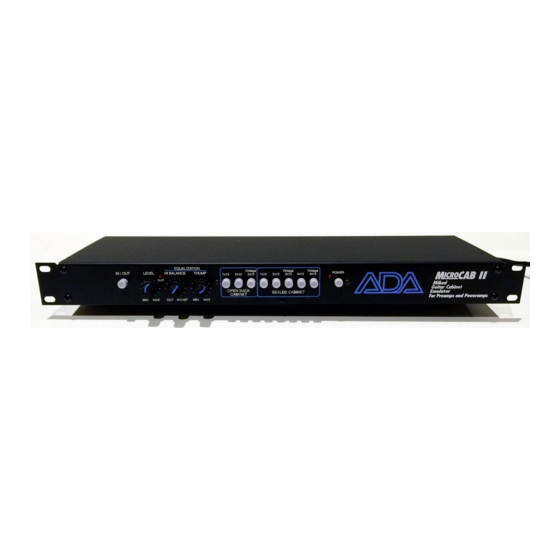Advertisement
Miked Guitar Cabinet Emulator for pre-amps
and power-amps
OWNER'S MANUAL Microcab II
(version 1)
Originally written by ADA SIGNAL PROCESSORS, INC. Scanned and edited by Jur at 10th of august 2002.
Original ADA logo edited and rendered by Barend Onneweer of Raamw3rk.) The version of this manual is
copyrighted and may not be sold or placed on a website without permission of the editor.
Release No.1 for
http://www.ada-mp1.com
Advertisement
Table of Contents

Summary of Contents for Ada Microcab II
- Page 1 OWNER’S MANUAL Microcab II (version 1) Originally written by ADA SIGNAL PROCESSORS, INC. Scanned and edited by Jur at 10th of august 2002. Original ADA logo edited and rendered by Barend Onneweer of Raamw3rk.) The version of this manual is copyrighted and may not be sold or placed on a website without permission of the editor.
-
Page 2: Table Of Contents
Table of Contents Introduction Features Precautions Quick Set Up Using the MicroCAB II How to Get the Best Tone with Your MicroCAB II What the MicroCAB II Docs Glossary of Audio Terms Specifications Page: 2... -
Page 3: Introduction
INTRODUCTION Thank you for purchasing the ADA MlCROCAB II Miked Guitar Cabinet Emulator. The MlCROCAB II is designed to deliver the distinct warmth and presence of a "close-miked" guitar speaker cabinet to a mixing console for direct recording or for sound reinforcement. -
Page 4: Quickset Up
EQ is essential to simulate the characteristic tone and presence of a "live" speaker cabinet. The ADA MlCROCAB II is designed to emulate the presence, tone and coloration found in a variety of modern and vintage speaker cabinets. Further, since the signal at the speaker... -
Page 5: How To Get The Best Tone With Your Microcab
You can also use the VINTAGE settings for a darker-sounding tone coloration. When using headphones with the MICROCAB II, you may want to adjust the HI BALANCE downward to compensate for high frequency emphasis found in most headphones. - Page 6 The purpose of calling the ADA MICROCAB II a "miked" guitar cabinet emulator is to distinguish it by features that account for the microphone in the audio path. As the number of speakers is increased in a miked cabinet, the number of signal paths to the microphone increases, adding a comb filter effect to the guitar sound on tape.
- Page 7 Page: 7...
-
Page 8: Glossary Of Audio Terms
200 Hz (abbr. for Hertz or cycles per second). The frequency is near the human chest cavity resonant frequency. The ADA MlCROCAB II is unique it its ability to reproduce this power and "live" feel in a direct situation—again giving "more tone to tape!"... - Page 9 Presence Range Refers to that area of the audio frequency spectrum which affects the perceived presence of the sound. Assuming there is no echo or reverb, presence or the feeling of being "up front" will be determined by the relative balance of those frequencies falling roughly in the 2 kHz to 5 kHz range.
-
Page 10: Specifications
cabinet, resulting in more complex and "darker" tone. The MlCROCAB II offers eight types of open/sealed enclosures. GRAPH C 4x12 / Sealed Cabinet / Off-Axis/On-Axis Miking This graph compares on-axis (solid line) vs. off-axis (dashed line) response characteristics in a close-miked 4x12 sealed cabinet. Note lower off-axis response above 2 kHz. resulting in less "brightness."...







Need help?
Do you have a question about the Microcab II and is the answer not in the manual?
Questions and answers